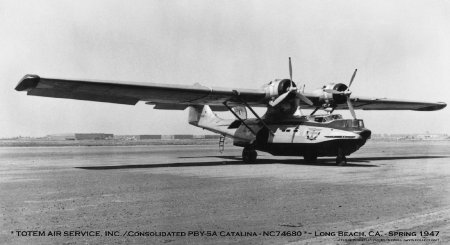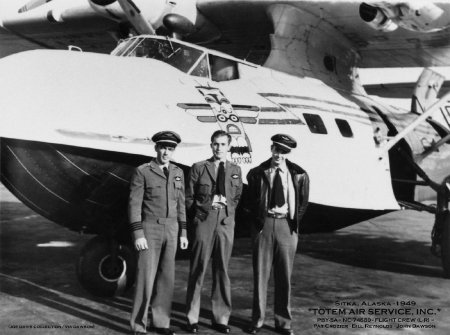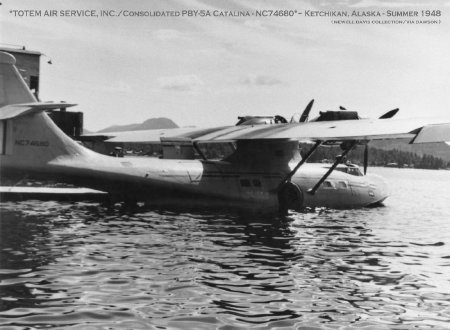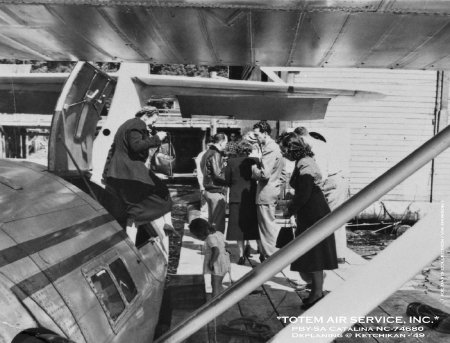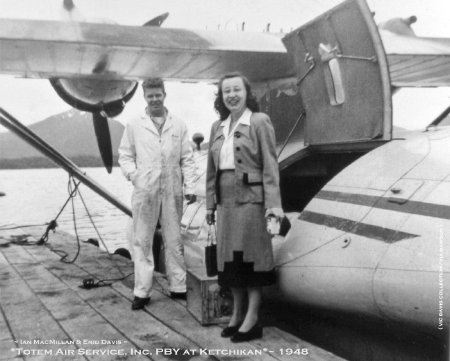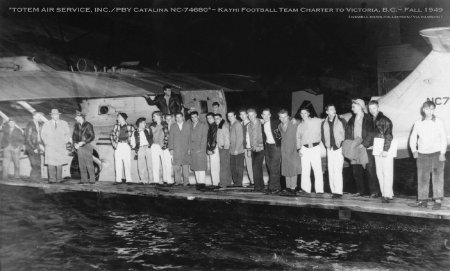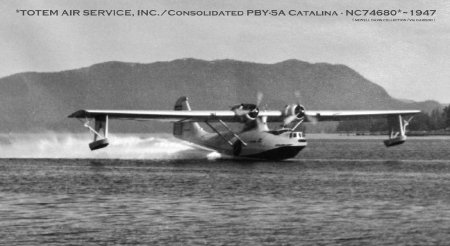Description:
Totem Air Service, 1947-1950
Totem Air Service, Inc. was founded in 1947 in Seattle, Washington by Floyd A. "Joe" Davis who served in Alaska with the Army during WWII, and then worked for the General Services Administration to help the Unangax people return to their villages in the Aleutians after being forcibly relocated during the war. Davis's initial commercial aviation venture was Golden North Airways in Fairbanks with two business partners. They purchased two surplus C-47s and a PBY-5A Catalina flying boat amphibian. The partnership soon split, but Davis retained the PBY with ambitions to launch a new airline to serve points in Southeast Alaska with connections to Seattle. Davis enlisted the help of his two brothers Newell and Victor Davis for the company management team. Newell had worked at North American Aviation for three years building B-25 bombers while studying engineering, followed by a two-year stint in the U.S. Marine Corps. Victor was a veteran U.S. Army Air Force pilot with a degree in commercial aviation. Newell became Totem Air Service's engineering and maintenance Vice President. Newell's first assigned duty was to accomplish the first U.S. PBY-5A commercial certification and civil airliner conversion of the type under new designation as a CV28-5ACF (Consolidated-Vultee Model 28-5 Amphibious Commercial Passenger/Freight). Appropriately dubbed "The Totem", the aircraft bore the registration number NC74680. The plush airliner's three main interior compartments could be quickly changed to freighter configuration by removing the passenger seats.
Service was inaugurated on August 8, 1947 after conducting Civil Aviation Authority required proving flights. The initial plan was to base the company at Boeing Field in Seattle and schedule weekly flights for Southeast Alaska bound passengers to Ketchikan, Wrangell, Petersburg, Juneau and Sitka. That was scaled down to just Ketchikan, Wrangell, and Sitka. Totem Air Service coordinated their flight departures to depart Seattle about the same time as Pan American Airways' big 4-engine clipper landplanes going to Annette Island Airport where arriving passengers would be required to take a small 9-place Grumman Goose amphibian shuttle to reach their final ticketed destination. Totem Air Service would instead fly direct to Ketchikan's downtown waterfront to deplane passengers at the Ketchikan Air Service dock, and then continue on to Wrangell and Sitka where the PBY utilized the demilitarized U.S. Navy Air Station facilities. Instrument Flight Rules flight letdowns were already in place at Annette Island Airport. During its years of operation, Totem Air Service got approval for instrument flights into Sitka.
It's important to note that during this heavily regulated Post WWII timeframe, Totem Air Service was not able to schedule daily service per Civil Aeronautics Board rules governing the proliferation of nonscheduled airlines starting up. In addition to eventually making two or three flights a week from Seattle, Totem Air Service offered air cargo services for heavy payloads, including fresh produce and special charter transport flights for commercial fishing companies for large size air-express shipments on a same day basis. Totem Air Service also offered transport flights for large groups of cannery workers heading back to Seattle at the end of the season. Many trips were logged to fish plants in Craig, Klawock, Wrangell, Petersburg, and others further north. By the end of April 1948, the PBY had completed over 75 trips.
As to a personnel roster: Dwayne Campbell, a U.S. Navy vet, was hired as Totem Air Service's first chief pilot, during the PBY's shakedown stage and proving flights. The primary Totem Air Service flight crew during the company's three and a half year tenure was comprised of three other highly trained WWII U.S. Navy veterans, all of whom were experienced in amphibious aircraft operations: Senior Pilot, Captain Forrest "Pat" Crozier; Copilot, Captain John Dawson; and Flight Engineer/Mechanic, William "Bill" Reynolds. PBY maintenance service in Seattle was contracted to West Coast Aircraft at Boeing Field and with Alaska Airlines, whose major overhaul facilities were then located at Paine Field in Everett, Washington. Ketchikan Air Service, owned by Stan Oaksmith, Jr. and Mart Hanson, handled routine maintenance required in Southeast Alaska. Totem Air Service's PBY docked at Ketchikan Air Service's dock at Ketchikan City Float during trips servicing Southeast Alaska. Vic Davis moved to Ketchikan with his wife Enid to serve as Totem Air Service's northern regional manager. Enid helped with ticketing and reservations. Lloyd Tilson was the local Ketchikan station manager. When Tilson left to fly for Ellis Air Lines, Ian MacMillan replaced him as station manager, and later became a Pan American Airlines captain. Earl Leding was Totem Air Service's Wrangell station manager and Russ Clithero, owner of the Sitka Hotel, ran Totem Air Service's Sitka office.
The Davis Brothers finally decided to shutdown Totem Air Service in 1950. Ironically, a couple years later, the Civil Aeronautics Board finally granted Totem Air Service their certificate of convenience to run full daily scheduled operations, but it came too late. N74680 was sold to Northern Consolidated Airlines in Anchorage, Alaska. A second PBY undergoing a conversion for Totem Air Service was sold before completion to a Catalina outfit. Vic Davis and Pat Crozier were both hired by Northern Consolidated Airlines, which eventually became part of Wien Air Alaska. Vic retired as Vice President in 1983 and Crozier retired as a B-737 Sr. Captain. Bill Reynolds also moved up to Anchorage to go work for the Federal Aviation Administration in Alaska as their general aviation chief maintenance inspector. Newell Davis joined Transocean Airlines and retired as a successful Seattle travel agency owner. Joe Davis retired a millionaire in Las Vegas. John Dawson settled in Juneau to fly for Alaska Coastal Airlines and he retired as a major car dealership owner in Juneau.
Totem Air Service set precedent with their PBY. In 1949, Alaska Coastal Airlines added PBYs to their large Juneau based commercial seaplane fleet to compete with Totem Air Service. Even the friendly rival in Ketchikan, Ellis Air Lines, eventually added a PBY to their fleet in 1959. Alaska Coastal - Ellis Airlines operated five different Catalinas in the Panhandle for nearly a quarter century alongside their large flock of Gooses. Alaska Airlines finally ended the amphibian flying boat tradition in Southeast Alaska in 1973.
In September 1977, Joe and Newell Davis visited Ketchikan and Sitka to commemorate the 30 year anniversary of Totem Air Service's debut in Southeast Alaska. Ian MacMillan and Stan Oaksmith, Jr. joined the brothers when they visited the Tongass Historical Museum in Ketchikan.
Service was inaugurated on August 8, 1947 after conducting Civil Aviation Authority required proving flights. The initial plan was to base the company at Boeing Field in Seattle and schedule weekly flights for Southeast Alaska bound passengers to Ketchikan, Wrangell, Petersburg, Juneau and Sitka. That was scaled down to just Ketchikan, Wrangell, and Sitka. Totem Air Service coordinated their flight departures to depart Seattle about the same time as Pan American Airways' big 4-engine clipper landplanes going to Annette Island Airport where arriving passengers would be required to take a small 9-place Grumman Goose amphibian shuttle to reach their final ticketed destination. Totem Air Service would instead fly direct to Ketchikan's downtown waterfront to deplane passengers at the Ketchikan Air Service dock, and then continue on to Wrangell and Sitka where the PBY utilized the demilitarized U.S. Navy Air Station facilities. Instrument Flight Rules flight letdowns were already in place at Annette Island Airport. During its years of operation, Totem Air Service got approval for instrument flights into Sitka.
It's important to note that during this heavily regulated Post WWII timeframe, Totem Air Service was not able to schedule daily service per Civil Aeronautics Board rules governing the proliferation of nonscheduled airlines starting up. In addition to eventually making two or three flights a week from Seattle, Totem Air Service offered air cargo services for heavy payloads, including fresh produce and special charter transport flights for commercial fishing companies for large size air-express shipments on a same day basis. Totem Air Service also offered transport flights for large groups of cannery workers heading back to Seattle at the end of the season. Many trips were logged to fish plants in Craig, Klawock, Wrangell, Petersburg, and others further north. By the end of April 1948, the PBY had completed over 75 trips.
As to a personnel roster: Dwayne Campbell, a U.S. Navy vet, was hired as Totem Air Service's first chief pilot, during the PBY's shakedown stage and proving flights. The primary Totem Air Service flight crew during the company's three and a half year tenure was comprised of three other highly trained WWII U.S. Navy veterans, all of whom were experienced in amphibious aircraft operations: Senior Pilot, Captain Forrest "Pat" Crozier; Copilot, Captain John Dawson; and Flight Engineer/Mechanic, William "Bill" Reynolds. PBY maintenance service in Seattle was contracted to West Coast Aircraft at Boeing Field and with Alaska Airlines, whose major overhaul facilities were then located at Paine Field in Everett, Washington. Ketchikan Air Service, owned by Stan Oaksmith, Jr. and Mart Hanson, handled routine maintenance required in Southeast Alaska. Totem Air Service's PBY docked at Ketchikan Air Service's dock at Ketchikan City Float during trips servicing Southeast Alaska. Vic Davis moved to Ketchikan with his wife Enid to serve as Totem Air Service's northern regional manager. Enid helped with ticketing and reservations. Lloyd Tilson was the local Ketchikan station manager. When Tilson left to fly for Ellis Air Lines, Ian MacMillan replaced him as station manager, and later became a Pan American Airlines captain. Earl Leding was Totem Air Service's Wrangell station manager and Russ Clithero, owner of the Sitka Hotel, ran Totem Air Service's Sitka office.
The Davis Brothers finally decided to shutdown Totem Air Service in 1950. Ironically, a couple years later, the Civil Aeronautics Board finally granted Totem Air Service their certificate of convenience to run full daily scheduled operations, but it came too late. N74680 was sold to Northern Consolidated Airlines in Anchorage, Alaska. A second PBY undergoing a conversion for Totem Air Service was sold before completion to a Catalina outfit. Vic Davis and Pat Crozier were both hired by Northern Consolidated Airlines, which eventually became part of Wien Air Alaska. Vic retired as Vice President in 1983 and Crozier retired as a B-737 Sr. Captain. Bill Reynolds also moved up to Anchorage to go work for the Federal Aviation Administration in Alaska as their general aviation chief maintenance inspector. Newell Davis joined Transocean Airlines and retired as a successful Seattle travel agency owner. Joe Davis retired a millionaire in Las Vegas. John Dawson settled in Juneau to fly for Alaska Coastal Airlines and he retired as a major car dealership owner in Juneau.
Totem Air Service set precedent with their PBY. In 1949, Alaska Coastal Airlines added PBYs to their large Juneau based commercial seaplane fleet to compete with Totem Air Service. Even the friendly rival in Ketchikan, Ellis Air Lines, eventually added a PBY to their fleet in 1959. Alaska Coastal - Ellis Airlines operated five different Catalinas in the Panhandle for nearly a quarter century alongside their large flock of Gooses. Alaska Airlines finally ended the amphibian flying boat tradition in Southeast Alaska in 1973.
In September 1977, Joe and Newell Davis visited Ketchikan and Sitka to commemorate the 30 year anniversary of Totem Air Service's debut in Southeast Alaska. Ian MacMillan and Stan Oaksmith, Jr. joined the brothers when they visited the Tongass Historical Museum in Ketchikan.
Click to Enlarge

